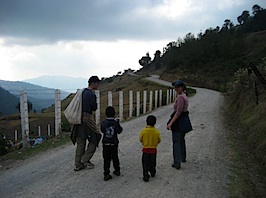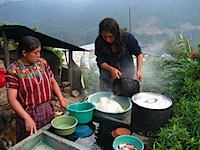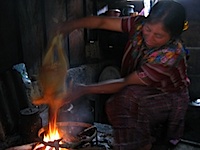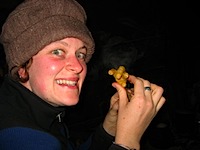WARNING: this post contains images that may be disturbing to some. If you are opposed to the killing of animals, you may want to skip this post. Likewise, if you are one of my friends that uses this blog as an educational took for your children, you may wish to review it alone first so you can better explain what’s going on.
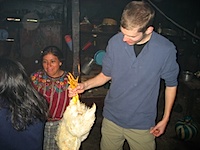 Welcome to the third installment of the “matando” series of lectures, where we talk about traditional rural meat processing techniques. Previous entries included matando kalnel (killing sheep), matando txitam (killing pigs), and today’s will be matando kaxlan (killing chickens).
Welcome to the third installment of the “matando” series of lectures, where we talk about traditional rural meat processing techniques. Previous entries included matando kalnel (killing sheep), matando txitam (killing pigs), and today’s will be matando kaxlan (killing chickens).
Our friend Devin is in town, and he wanted to do something nice for our neighbors. Emily had a great idea: how about buying a tasty chicken for them to put into their stew pot? Chicken stew is a favorite around here, and people don’t get to eat it a lot because meat is expensive. “You mean, a live chicken?” Devin asked, getting into the spirit of things. Um, we hadn’t really thought about that. So we mentioned it to the neighbors, who immediately realized that if we bought a live chicken, they would be the ones killing and cleaning it. They teased us a bit, then agreed: it’s hard to turn down a 100q gift, even if it does mean a little dirty work.
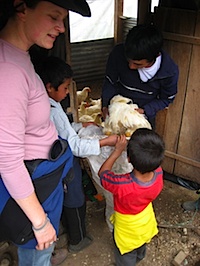 So, we headed off on a hike to the neighboring village, where they sell roasting chickens. They sent Chalio and Alberto as our hobbit guides. Not only did we not know where the chickens were to be found, but we also don’t speak enough Q’anjob’al to do a good job with the negotiations. Turns out, sending the kids to help the bumbling adults was a great idea. Chalio did as good a job as you could expect from any 10-year-old, and he picked out the biggest chicken in the pen. He then got them to charge us only 90q instead of the expected 100. Success!
So, we headed off on a hike to the neighboring village, where they sell roasting chickens. They sent Chalio and Alberto as our hobbit guides. Not only did we not know where the chickens were to be found, but we also don’t speak enough Q’anjob’al to do a good job with the negotiations. Turns out, sending the kids to help the bumbling adults was a great idea. Chalio did as good a job as you could expect from any 10-year-old, and he picked out the biggest chicken in the pen. He then got them to charge us only 90q instead of the expected 100. Success!
Chicken in sack, we headed back home. The bird was kindof heavy and prone to occasional fits of squawking and flapping, so Emily and Devin traded off carrying. If you enlarge the picture, you can see a chicken toenail poking out of the gunnysack on one side, and a beak on the other.
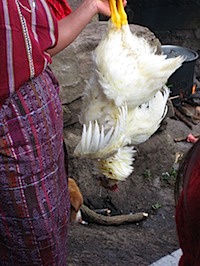 When we arrived at our neighbor’s, Emily asked how they kill it. We had imagined cutting heads off with axes and chickens running around headless, as we were told by our grandparents, but it turns out it’s a lot less dramatic or messy. Masha holds the chicken so it can’t flap, and Reyna twists the head around and around. At some point, it’s more than the design load of the chicken, and death results.
When we arrived at our neighbor’s, Emily asked how they kill it. We had imagined cutting heads off with axes and chickens running around headless, as we were told by our grandparents, but it turns out it’s a lot less dramatic or messy. Masha holds the chicken so it can’t flap, and Reyna twists the head around and around. At some point, it’s more than the design load of the chicken, and death results.
Then they take the drooling, limp chicken outside to the rubber basin where they pour boiling water over it. That loosens the feathers so they come out easier. Reyna and Masha make short work of it, then the chicken goes inside to be dangled over the fire, burning off the pinfeathers.
Then it’s back out to the sink and the knife. “Guess what?” Devin asks as they cut off the part that holds the tail feathers. “What?” I reply. “CHICKEN BUTT!” he exclaims.
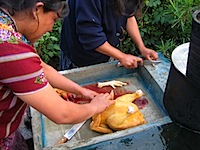 The rest of it was pretty straightforward. I only cringed at one part, and it was not because of all the blood-n-guts. Check out what they’re doing with that nice knife I got them for christmas: they’re cutting with it directly on concrete! AAAAAAA! When you give something away as a present, you just have to let it go, I guess. Let it go. Let it go.
The rest of it was pretty straightforward. I only cringed at one part, and it was not because of all the blood-n-guts. Check out what they’re doing with that nice knife I got them for christmas: they’re cutting with it directly on concrete! AAAAAAA! When you give something away as a present, you just have to let it go, I guess. Let it go. Let it go.
Once drawn and quartered, the chicken gets stewed. They like to cook the feet, too, as they lend a tasty flavor and add the yellow color to the stew. Everything goes into a big boiling pot, along with a few tomatoes, some monte (random green plants pulled from the hillside) and about half a cup of salt. They love salt. A few hours later, once the chicken is cooked, it comes out of the pot and they pour in some macaroni. While the macaroni is getting soft, Lina (the mom) tears the steaming chicken apart into chunks, and distributes it evenly between all the waiting bowls. Then, the broth/macaroni soup is ladled on top. Dinner for all!
Here are Devin and Emily nibbling on tasty chicken toes. I would have none of it; I put up with enough food foolishness in Guatemala as it is.
